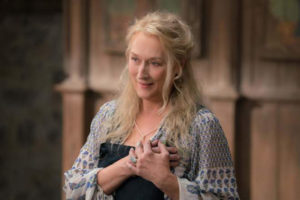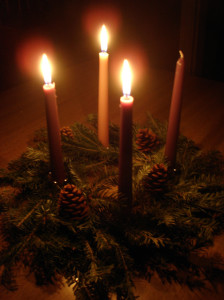The nights have been growing longer since June and in two weeks time, we reach the culmination of that progression of darkness: it will be the Midwinter Solstice, the longest night of the year in the Northern Hemisphere. By now, in early December, as each day grows shorter and each night longer, it is easy to get lost in the darkness. But our celebrations at this time of year call down the light. Last Sunday, we celebrated with candlelight across traditions: It was the First Night of Hanukkah and the First Sunday of Advent. Wednesday night brought the Eve of St. Nicholas and Thursday, St. Nicholas’ Day. He is the first of our midwinter gift bearers, leaving small, simple presents in the shoes of sleeping children. Next week will come Santa Lucia, who also pierces the darkness with light––in Sweden, at the top of the world near the Arctic Circle, where darkness envelops the greater part of each day this time of year, she is known as Sankta Lucia. Young girls there will wear crowns of lit candles on their heads, as star boys accompany them with light of their own, all of them singing the most haunting song, “Sankta Lucia,” an old Italian melody sung with the distinctly soft S sounds that come with Swedish lyrics.
These are some of our favorite nights of the year, these nights leading up to the magic of Christmas. To help you keep track of each of them, here is our December gift to you: the Convivio Book of Days Calendar for December. It’s a PDF document, printable on standard US Letter size paper, a fine companion to this Book of Days (especially on the days when I don’t have time to write, which has happened a lot lately). As we progress through December, the darkness will increase, but so will our candlelight as we complete the Hanukkah festival and go through our Advent journey toward Christmas, preparing the light of the world. The illumination, the imagery, is powerful magic in dark times. We’re here sharing it with you throughout. These are some of our deepest joys.
COME SEE US!
We’re popping up at two local pop-up markets this week, one in Boca Raton on Friday, and the other on Sunday afternoon right here in Downtown Lake Worth. We’re also working on popping up at the Lake Worth Nutcracker Festival on Saturday December 15… but we keep forgetting to submit our application. Perhaps tomorrow. These, meanwhile, are definitely on the calendar:
REAL MAIL FRIDAYS: Winter Card Writing Social
Friday December 7 from 12 noon to 6 PM
Jaffe Center for Book Arts at Florida Atlantic University’s Wimberly Library, Boca Raton
We’ll be in the company of a few other local makers with a mini pop-up shop of traditional handmade goods for Christmas made by artisans in Germany’s Ergebirge and San Miguel de Allende, Mexico. It’s a fun event designed to help you get your holiday cards written and in the mail.
REVELRY LAKE WORTH SIP & SHOP
Sunday December 9 from 1 to 6 PM
Revelry Lake Worth
17 South J Street in Downtown Lake Worth, in the outdoor courtyard.
We’ll be in a tent with our Shaker herbs and teas, wreaths made of candy, and traditional handmade goods for Christmas made by artisans in Germany’s Ergebirge and San Miguel de Allende, Mexico.
And for our friends who are not so near…
CONVIVIO by MAIL
Our Convivio Book of Days Catalog pages are full of great little holiday presents, from handmade soaps (the gingerbread man is back!) to genuine Shaker culinary herbs and herbal teas to traditional Christmas decorations from Germany, Spain, and Mexico… our favorite this year may just be the painted tin nativity that opens like a pop-up book and folds down flat when you’re done with it. FREE SHIPPING for domestic orders when you spend $50… spend less and shipping is just a flat rate fee of $8.50. No coupon code necessary; free shipping happens automatically when you spend $50 or more.


